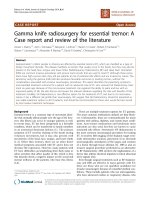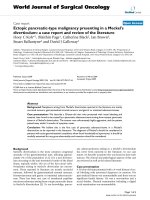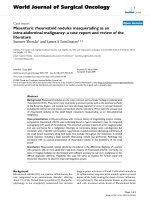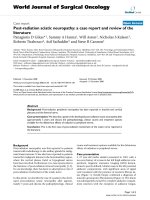Báo cáo y học: "Dentin dysplasia type I: a case report and review of the literature" ppsx
Bạn đang xem bản rút gọn của tài liệu. Xem và tải ngay bản đầy đủ của tài liệu tại đây (1.27 MB, 6 trang )
CAS E REP O R T Open Access
Dentin dysplasia type I: a case report and review
of the literature
Lida Toomarian
1
, Fatemeh Mashhadiabbas
2
, Mahkameh Mirkarimi
3*
, Leili Mehrdad
4
Abstract
Introduction: Dentin dysplasia is a rare hereditary disturbance of dentin formation characterized by defective
dentin development with clinically normal appearing crowns, severe hypermobility of teeth and spontaneous
dental abscesses or cysts. Radiographic analysis shows obliteration of all pulp chambers, short, blunte d and
malformed or absent roots and peri-apical radiolucencies of non carious teeth.
Case presentation: We present a case of dentin dysplasia type I in a 12-year-old Iranian boy, and the clinical,
radiographic and histopathologic findings of this condition and treatment are described.
Conclusions: There are still many inconclusive issues in the diagnosis and management of patients with dent in
dysplasia. The diagnostic features of this rare disturbance will remain incompletely defined until additional cases
have been described. Early diagnosis of the condition and initiation of effective regular dental treatments may help
these pa tients to prevent or delay loss of dentition.
Introduction
Dentin dysplasia (DD) is an autosomal dominant heredi-
tary disturbance in dentin formation, which may present
with either mobile teeth or pain associated with sponta-
neous dental abscesses or cysts. It is a rare anomaly of
unknown etiology that affects approximately one patient
in every 100,000 [1]. The condition was first described
by Ballschmiede [2] but it was Rushton [3] who termed
the condition dentinal dysplasia. This condition is rarely
encountered in dental practice. In 1972, Witkop [4] clas-
sified DD into two types, radicular DD as type I and
coronal DD as type II. In type I, both the deciduous and
permanent dentitions are affected. The crowns of the
teeth appear clinically normal in morphology but defects
in dentin formation and pulp obliteration are present.
Radiographic examination is important for the identifi-
cation of DD type I. There are four subtypes for this
abnormality. In type 1a, there is no pulp chamber and
root formation, and there are frequent periradicular
radiolucencies; type 1b has a single small horizontally
oriented and crescent shaped pulp, and roots are only a
few millimeters in length and there are frequent peri-
apical radiolucencies; in type 1c, there are two
horizonta l or ve rtical and crescent shaped pulpal r em-
nants surrounding a central island of dentine and with
significant but shortened root length and variab le peri-
apical radiolucencies; in type 1d, there is a visible pulp
chamber and cana l with near-normal root length, and
large pulp stones that are located in the coronal portion
of the canal and create a localized bulging in the canal,
as well as root constriction of the pulp canal apical to
the stone and few peri-apical radiolucencies [5]. Histolo-
gically, the enamel and the immediately subjacent dentin
appear normal. Deeper layers of dentin show an atypical
tubular pattern with an amorphous, atubular area and
irregular organization. Pulpally to normal appearing
mantle dentin, and globular or nodular masses of abnor-
mal dentin are seen [6]. It is not known if DD type I is
another allelic disorder of the dentin sialophosphopr o-
tein (DSPP) gene, or a mixed phenotype [1].
This article describes an uncommon case of DD type
I, subty pe 1a, in a 12-year-old Iranian boy, highlighting
the clinical and radiographic variations of the defect as
confirmed by histopathologic examination.
Case presentation
A 12-year-old I ranian boy was referred to the Pedodon-
tics Department of Shaheed Beheshti University Medical
Sciences, Dental School due to excessive painful swelling
* Correspondence:
3
Pediatric Department, Zahedan University of Medical Sciences, Zahedan,
Iran
Toomarian et al. Journal of Medical Case Reports 2010, 4:1
/>JOURNAL OF MEDICAL
CASE REPORTS
© 2010 Toomarian et al; licensee BioMed Central Ltd. This is an Open Access article distributed under the terms of the Creative
Commons Attribution License ( s/by/2.0), which pe rmits unrestricted use, distribution, and
reproduction in any me dium, pr ovided the original work is properly cited.
of his mandibular left cheek region. Clinical examination
showed that the following teeth were present in his
mouth:
7654321 12 C4567
7654321 12 C4567
The crowns of his teeth had normal morphologic
characteristics, but the colo r of his teeth was slightly
more yellow than expected for a patient of his age (Fig-
ure1,Figure2,Figure3).Oralhygienewaspoorand
there were plaque deposits present in all quadrants. The
patient’s medical history revealed no evidence of distur-
bance in general health. Caries were present in most of
the teeth. The maxillary and mandibular central and lat-
eral incisors were mobile, and there was a painful
expansion on the buccal region of the mandibular left
first molar. Information supplied by his mother indi-
cated that the child’ s gingiva had become markedly
swollen in both upper and lower jaws on various occa-
sions and that this condition had been treated by anti-
biotic therapy. Radiographic examinat ion revealed
pulpless teeth with no root formation in most teeth and
roots of only a few millimeters in some teeth. There was
a well-defined round unilocu lar radioluce ncy in associa-
tion with the apex of the left first permanent molar. The
left maxillary and mandibular cani ne teeth were
impacted and located horizontally in panoramic view
(Figure 4).
On the basis of the clinical and radiographic appear-
ance, a diagnosis of DD type I, subtype 1a, was sus-
pected. Clinical and ra diographical examination of the
patient’ s parents and siblings revealed no cases of DD
type I, and there were no previous cases of this distur-
bance in the familial history. The following treatment
plan was formulated: dietary and oral hygiene instruc-
tions, fluoride supplements, surgical enucleating of the
cystic lesion at the left first permanent molar region,
restoration of the carious teeth, and extraction of the
left primary canine and primary first molar, which were
carious and mobile.
The cystic lesion was enucleated and sent for histo-
pathological examination. Based on the pedodontist’s
and surgeon’ s view, it was decided to extract the
remaining root of the lower left first permanent molar
during surgery because of extensive c aries. The histo-
pathological features were consistent with the clinical
diagnosis of a radicular cyst. The cystic cavit y was lined
with a variable thickne ss of non keratinized stratified
squamous epithelium with arch-shaped appearance and
exocytosis in the underlying connective tissue was
severely infiltrated by chronic inflammatory cells. Extra-
vasated red blood cells and hemosiderin pigments were
also seen (Figure 5). The extracted primary teeth were
sent for histological examination. The ground section
was examined with a stereomicroscope: the superficial
dentin of the crown appeared normal, but the pulp
chamber was obliterated by an unusual type of calci fied
material consistin g of dentin, and deeper layers of den-
tin had an atypical tubular pattern (Figure 6). These fea-
tures are consistent with those of DD type I, confirming
the diagnosis based on the clinical and radiographic fea-
tures. It is anticipated that more permanent teeth may
be lost due to severe mobilit y and may undergo sponta-
neous pulpal necrosis. The possibility of endosseo us
implants is being explored for when the patient reach es
his late teens and growth is complete.
Figure 1 Intra-oral image before treatment.
Toomarian et al. Journal of Medical Case Reports 2010, 4:1
/>Page 2 of 6
Discussion
ThepathogenesisofDDisstillunknowninthedental
literature. Logan et al. [7] proposed that it is the dent-
inal papilla that is responsible for the abnormalities in
root d evelopm ent. They suggested that multiple degen-
erative foci within the papilla become calcified, leading
to reduced growth and final obliteration of the pulp
space. Wesley et al. [8] proposed that the condition is
caused by an abnorm al interaction of odontobla sts with
ameloblasts leading to abnormal differentiation and/or
function of these odontoblasts. Dentin dysplasia type I
should be differentiated from dentin dysplasia type II,
dentinogenesis imperfecta and odontodysplasia. In our
patient, the calcified pulp chambers, rootless teeth, peri-
apical radiolucent areas and the nature of the peri-apical
lesion are characteris tic findings for the diagnosis of DD
type 1, sub type 1a. DD is usually an autosomal domi-
nant condition [1], but in this patient, there was no
familial history of the disease, so he is considered to be
a first generation sufferer. Teeth with radiographic or
Figure 2 View of maxillary teeth before treatment.
Figure 3 View of mandibular teeth before treatment.
Toomarian et al. Journal of Medical Case Reports 2010, 4:1
/>Page 3 of 6
histologic features of DD occur in a number of disorders
such as calcinosis, Ehlers-Danlos syndrome, and the bra-
chioskeletogenital syndrome [9]. Some association has
also been reported between dentine dysplasia and oss-
eous changes in addition to sclerotic bone formation
[10] but our patient had no signs of other pathologic
conditions.
There were no variations in the morphology of the
affected teeth in our patient but there are reports that
have suggested possible variations in the morpholo gy of
teeth affected by this type of dysplasia [11,12]. Histo-
pathologically, the peri-apical radiolucent areas seen in
most cases of DD have been interpreted as radicular
cysts, however, in some cases, a diagnosis of peri-apical
granuloma has been reported [13].
Management of patients with dentinal dysplasia has
presented dentists with many problems. Extraction has
been suggested as a treatment alte rnative for teeth with
Figure 4 Panoramic radiography before treatment.
Figure 5 In hist opathologic examination, a variable thickness of non-keratinized stratified squamous epithelium with arch-shaped
appearance is evident (×40).
Toomarian et al. Journal of Medical Case Reports 2010, 4:1
/>Page 4 of 6
pulp necrosis and peri-apical a bscess. Follow-up and
routine conservative treatment is another choice of
treatment plan in DD [13]. Another approach for the
treatment of teeth with DD has included peri-apical sur-
gery and retrograde filling, which is recommended in
teeth with long roots [13,14]. Since these patients
usually have early exfoliat ion of the teeth and, conse-
quently, maxillomandibular bony atrophy, treatment
with a combination of onlay bone grafting and a sinus
lift technique to accomplish implant placement can be
used successfully [15].
Conclusion
Dentin dysplasia type I is a rare inherited abnormality of
the dentin that leads to premature exfoliation of the pri-
mary and permanent teeth. Early diagnosis of the condi-
tion is important for initiation of effective preventive
treatment. In this regard, the pediatric dentist has an
important role in the early diagnosis o f this disorder
and i n guiding patients in the selection of measures to
prolong the retention of affected teeth.
Consent
Written informed consent was obtained from the
patient’s parents for publication of this case report and
any accompanying images. A copy of the written con-
sent is available fo r review by the Editor-in-Chief of this
journal.
Abbreviations
DSPP: dentin sialophosphoprotein.
Author details
1
Pediatric Department, Shahid Beheshti University, Tehran, Iran.
2
Oral and
Maxillofacial Pathology Department, Shahid Beheshti University, Tehran, Iran.
3
Pediatric Department, Zahedan University of Medical Sciences, Zahedan,
Iran.
4
Private practice, Tehran, Iran.
Authors’ contributions
LT wrote and supervised the manuscript. FM carried out the pathologic
issues and took the ground section. MM and LM carried out all dental
treatments and completed the literature review.
Competing interests
The authors declare that they have no competing interests.
Received: 30 November 2008
Accepted: 7 January 2010 Published: 7 January 2010
References
1. Kim JW, Simmer JP: Hereditary dentin defects. Dent Res 2007, 86:392-399.
2. Ballschmiede G: Dissertation, Berlin, 1920. Malformations of the Jaws and
Teeth New York: Oxford University PressHerbst E, Apffelstaedt M 1930, 286.
3. Rushton MA: A case of dentinal dysplasia. Guy’s Hospital Report 1939,
89:369-373.
Figure 6 Ground section view with stereomicroscope showing normal coronal dentin and irregular dentine obliterating the pulp
chamber.
Toomarian et al. Journal of Medical Case Reports 2010, 4:1
/>Page 5 of 6
4. Witkop CJ Jr: Hereditary defects of dentin. Dent Clin North Am 1975, 19:25-
45.
5. Neville B, Damm D, Allen C, Bouquot J: Oral and Maxillofacial Pathology.
Elsevier, 3 2008.
6. Regezi JA, Sciubba JJ, Jordan RCK: Oral Pathology Clinical Pathologic
Correlations. Saunders, 5 2008.
7. Logan J, Becks H, Silverman S, Pinborg JJ: Dentinal dysplasia. Oral Surg
1962, 15:317-333.
8. Wesley RK, Wysocki GP, Mintz SM, Jackson J: Dentin dysplasia type I. Oral
Surg 1976, 41:516-524.
9. Perl T, Farman AG, Elizabeth P, Town C: Radicular (Type I) dentin
dysplasia. Oral Surg Oral Med Oral Pathol 1977, 43:746-753.
10. Morris ME, Augsburger RH: Dentine dysplasia with sclerotic bone and
skeletal anomalies inherited as an autosomal dominant trait. Oral Surg
Oral Med Oral Pathol 1977, 43:267-283.
11. Elzay RP, Robinson CT: Dentinal dysplasia, report of a case. Oral Surg 1967,
23:338-342.
12. Ozer L, Karasu H, Aras K, Tokman B, Ersoy E: Dentin dysplasia type I: report
of atypical cases in the permanent and mixed dentitions. Med Oral
Pathol Oral Radiol Endod 2004, 98:85-90.
13. Ravanshad SH, Khayat A: Endodontic therapy on a dentition exhibiting
multiple periapical radiolucencies associated with dentinal dysplasia
type 1. Aust Endod J 2006, 32:40-42.
14. Ansari G, Reid JS: Dentinal dysplasia type I: review of the literature and
report of a family. ASDC J Dent Child 1997, 64:429-434.
15. Muñoz-Guerra MF, Naval-Gías L, Escorial V, Sastre-Pérez J: Dentin dysplasia
type I treated with onlay bone grafting, sinus augmentation, and
osseointegrated implants. Implant Dent 2006, 15:248-253.
doi:10.1186/1752-1947-4-1
Cite this article as: Toomarian et al.: Dentin dysplasia type I: a case
report and review of the literature. Journal of Medical Case Reports 2010
4:1.
Publish with Bio Med Central and every
scientist can read your work free of charge
"BioMed Central will be the most significant development for
disseminating the results of biomedical research in our lifetime."
Sir Paul Nurse, Cancer Research UK
Your research papers will be:
available free of charge to the entire biomedical community
peer reviewed and published immediately upon acceptance
cited in PubMed and archived on PubMed Central
yours — you keep the copyright
Submit your manuscript here:
/>BioMedcentral
Toomarian et al. Journal of Medical Case Reports 2010, 4:1
/>Page 6 of 6









